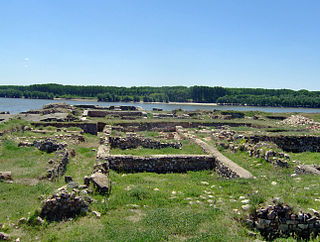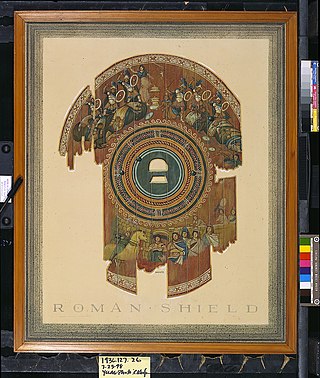
Dura-Europos was a Hellenistic, Parthian, and Roman border city built on an escarpment 90 metres above the southwestern bank of the Euphrates river. It is located near the village of Salhiyé, in present-day Syria. Dura-Europos was founded around 300 BC by Seleucus I Nicator, who founded the Seleucid Empire as one of the Diadochi of Alexander the Great. In 113 BC, Parthians conquered the city, and held it, with one brief Roman intermission, until 165 AD. Under Parthian rule, it became an important provincial administrative centre. The Romans decisively captured Dura-Europos in 165 AD and greatly enlarged it as their easternmost stronghold in Mesopotamia, until it was captured by the Sasanian Empire after a siege in 256–57 AD. Its population was deported, and the abandoned city eventually became covered by sand and mud and disappeared from sight.

The Dura-Europos synagogue was an ancient synagogue uncovered at Dura-Europos, Syria, in 1932. The synagogue contains a forecourt and house of assembly with painted walls depicting people and animals, and a Torah shrine in the western wall facing Jerusalem. It was built backing on to the city wall, which was important in its survival. The last phase of construction was dated by an Aramaic inscription to 244 CE, making it one of the oldest synagogues in the world. It was unique among the many ancient synagogues that have emerged from archaeological excavations as the structure was preserved virtually intact, and it had extensive figurative wall-paintings, which came as a considerable surprise to scholars. These paintings are now displayed in the National Museum of Damascus.

The scutum was a type of shield used among Italic peoples in

Serbinum, also known as Serbitium or Serbicium, was an ancient Roman city in the province of Pannonia. It was situated in what is now Gradiška in northern Bosnia and Herzegovina.

The National Museum of Damascus is a museum in the heart of Damascus, Syria. As the country's national museum as well as its largest, this museum covers the entire range of Syrian history over a span of over 11 millennia. It displays various important artifacts, relics and major finds most notably from Mari, Ebla and Ugarit, three of Syria's most important ancient archaeological sites. Established in 1919, during King Faisal's Arab Kingdom of Syria, the museum is the oldest cultural heritage institution in Syria.

A road map, route map, or street map is a map that primarily displays roads and transport links rather than natural geographical information. It is a type of navigational map that commonly includes political boundaries and labels, making it also a type of political map. In addition to roads and boundaries, road maps often include points of interest, such as prominent businesses or buildings, tourism sites, parks and recreational facilities, hotels and restaurants, as well as airports and train stations. A road map may also document non-automotive transit routes, although often these are found only on transit maps.
Robert Orwill Fink was an American papyrologist with a special interest in Roman military papyri.

Dura Parchment 24, designated as Uncial 0212, is a Greek uncial manuscript of the New Testament. The manuscript has been assigned to the 3rd century, palaeographically, though an earlier date cannot be excluded. It contains some unusual orthographic features, which have been found nowhere else.

Capidava was an important Geto-Dacian center on the right bank of the Danube. After the Roman conquest, it became a civil and military center, as part of the province of Moesia Inferior, modern Dobruja.
The Feriale Duranum is a calendar of religious observances for a Roman military garrison at Dura-Europos on the Euphrates, Roman Syria, under the reign of Severus Alexander.
Albaniana was the name the ancient Romans gave a settlement on the southern banks of Rhine river, some 40 kilometers from its mouth in the North Sea, known as Alfen and modern-day Alphen aan den Rijn, Netherlands. They did build a military fort there, as part of a range strategically built encampments, to protect and guard the river, frontier (limes) of the Roman empire and main transport route of goods and troops. The historical map Tabula Peutingeriana situates the settlement in between Matilo (Leiden) and Praetorium Agrippinae (Valkenburg) downstream and Nigrum Pullum (Zwammerdam) and Fectio (Vechten) upstream. The village was mentioned in Antoninus' register of roads Itinerarium Antonini from the 3rd century. The fortress must have been surrounded by a wall of ground and wooden poles, with gates and watch towers.

The siege of Dura Europos took place when the Sasanians under Shapur I besieged the Roman city of Dura-Europos in 256 after capturing Antioch.
Caenophrurium was a settlement in the Roman province of Europa, between Byzantium and Heraclea Perinthus. It appears in late Roman and early Byzantine accounts. Caenophrurium translates as the "stronghold of the Caeni", a Thracian tribe.

The Temple of the Gadde is a temple in the modern-day Syrian city of Dura-Europos, located near the agora. It contained reliefs dedicated to the tutelary deities of Dura-Europos and the nearby city of Palmyra, after whom the temple was named by its excavators. The temple was excavated between 1934 and January 1936 by the French/American expedition of Yale University, led by Michael Rostovtzeff.

Coele Syria was a Roman province which Septimius Severus created with Syria Phoenice in 198 by dividing the province of Syria. Its metropolis was Antioch.

The Danum shield was a Roman shield found in the Danum Roman fort at Doncaster in 1971. It was discovered amid the remains of a bonfire and may have been intentionally disposed of during the partial abandonment of the fort. The shield was rectangular in shape and measured approximately 0.65 metres (2.1 ft) by 1.25 metres (4.1 ft). It is considered to have been part of the equipment of a Roman auxilium (non-citizen) soldier. An assessment in the 1970s considered it to have had an unusual vertical hand grip, suggesting a possible use by cavalry. However a recent work suggests the handgrip may have been horizontal and the shield used by an infantryman. The shield was covered in leather and was probably painted, though its original colour is not known. The outer face was decorated with bronze sheeting, possibly incised with a Celtic pattern.

The Mithraeum of Dura Europos was found during excavations in the city in 1934. It is considered to be one of the best-preserved and best-documented cult buildings of Mithraism.

The temple of Artemis Azzanathkona is located in Dura Europos in the east of present-day Syria, and was dedicated to a syncretic belief of Artemis and Azzanathkona.

The Homeric shield is one of three figural painted shields found together in an embankment within a Roman garrison during the excavations of Dura-Europos. Dura-Europos was a border city of various empires throughout antiquity, and in modern archaeology is noteworthy for its large amount of well-preserved artifacts. Having been virtually untouched for centuries, and with favorable soil, an unusual amount of organic material has been preserved at Dura-Europos. This shield and those found alongside it date from the middle of the 3rd century CE, a period in which a large portion of the city was co-opted as a Roman military base. The shields were deliberately discarded unfinished during the Sassanian siege of Dura Europos. It is widely believed to depict two scenes from the Trojan war: the admission of the Trojan horse into Troy, and the subsequent sack of the city. It is one of few examples of Roman painting on wood, and one of very few Roman painted wooden shields to have survived from antiquity. The shield has now deteriorated beyond most detail being discernible to the naked eye. This is due to the unintended adverse effects of a binding agent applied to the shield in the 1930s in the hopes of preserving the pigmentation.
















